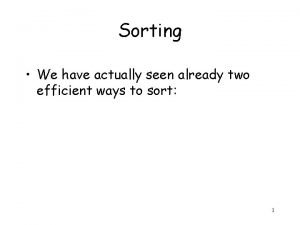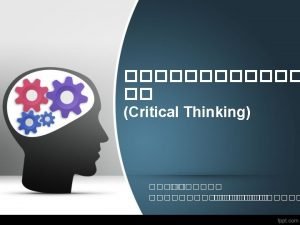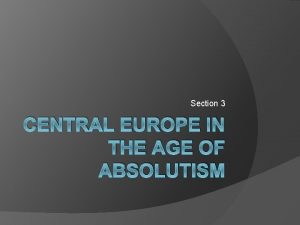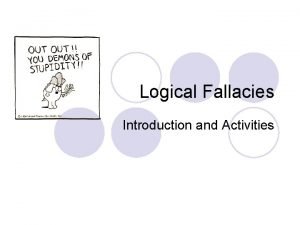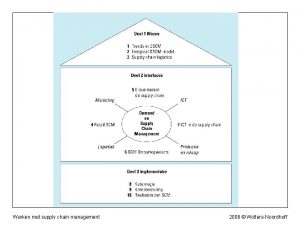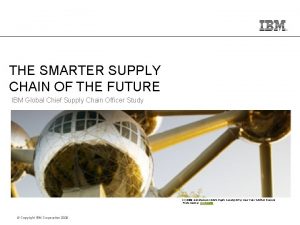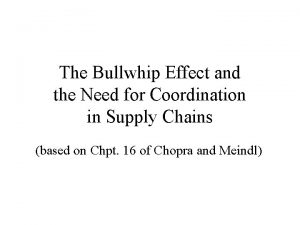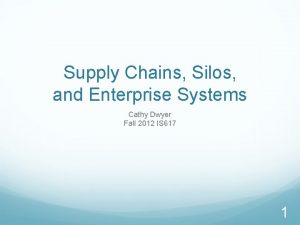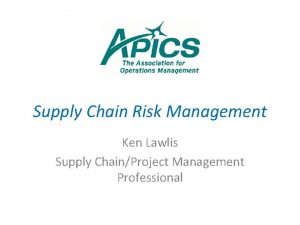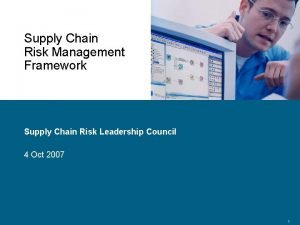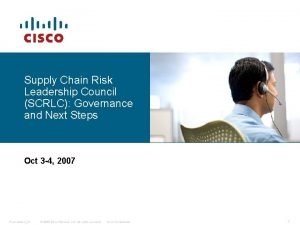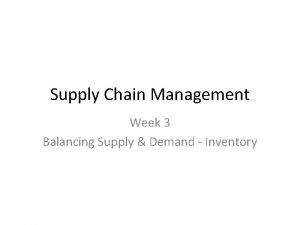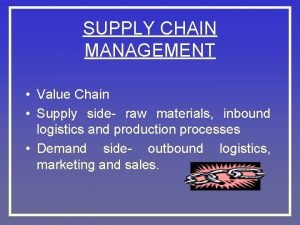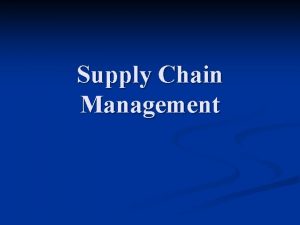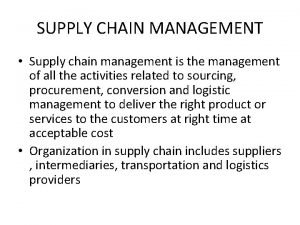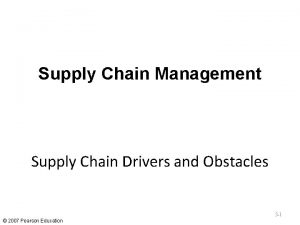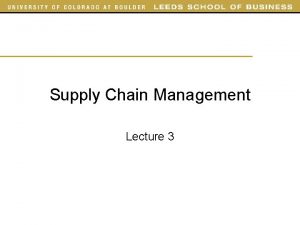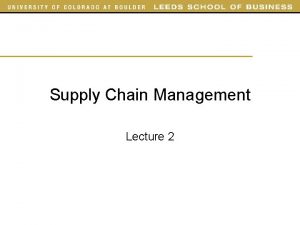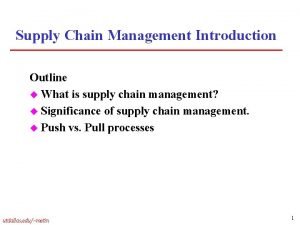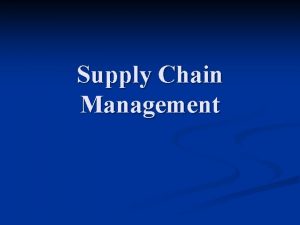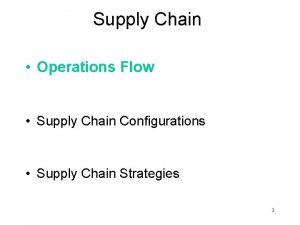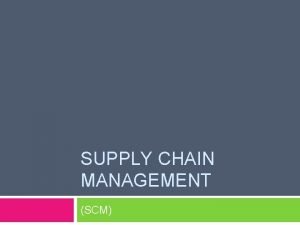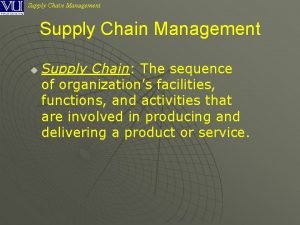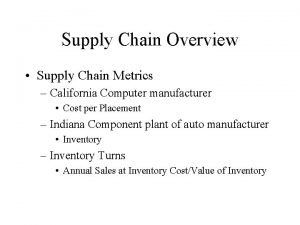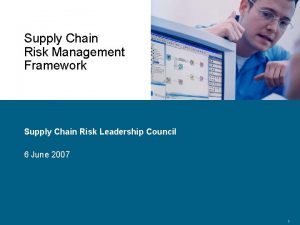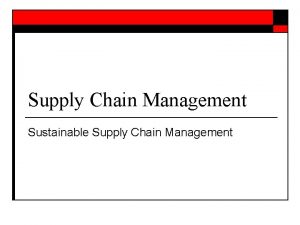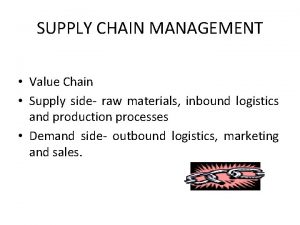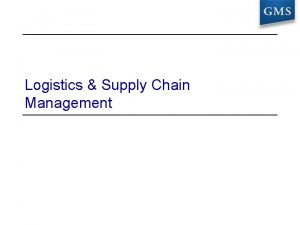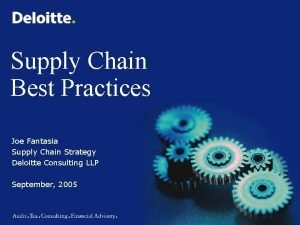Supply Chain Modelling n There actually four common




































- Slides: 36






















Supply Chain Modelling n There actually four common Supply Chain Models. n n n Supply Chain Operations Reference(SCOR) Model Global Supply Chain Forum(GSCF) Model American Productivity & Quality Center's (APQC) Process Classification Framework Supply Chain Best Practices Framework. Critics has questioned the validity of all these models. 제 7장. 가치체인(value chain) 22

Supply Chain Modelling-1 n SCOR (Supply Chain Operations Reference) model, n n developed by the Supply Chain Council, measures total supply chain performance. It is a process reference model for supply-chain management, spanning from the supplier's supplier to the customer's customer. It includes delivery and order fulfillment performance, production flexibility, warranty and returns processing costs, inventory and asset turns, and other factors in evaluating the overall effective performance of a supply chain. 제 7장. 가치체인(value chain) 23

Supply Chain Modelling-2 n GSCF Supply Chain Model. n n Introduced by Global Supply Chain Forum (GSCF) This framework is built on eight key business processes that are both cross-functional and cross-firm in nature. Each process is managed by a cross-functional team, including representatives from logistics, production, purchasing, finance, marketing and research and development. While each process will interface with key customers and suppliers, the customer relationship management and supplier relationship management processes form the critical linkages in the supply chain. 제 7장. 가치체인(value chain) 24

Supply Chain Modelling-2 GSCF Supply Chain Model Eight Key Business Processes. 제 7장. 가치체인(value chain) 25

Objectives of SCM n n n The primary objective of supply chain management is to fulfill customer demands through the most efficient use of resources, including distribution capacity, inventory and labor. In theory, a supply chain seeks to match demand with supply and do so with the minimal inventory. Various aspects of optimizing the supply chain include n n n liaising with suppliers to eliminate bottlenecks; sourcing strategically to strike a balance between lowest material cost and transportation, implementing JIT (Just In Time) techniques to optimize manufacturing flow; maintaining the right mix and location of factories and warehouses to serve customer markets using location/allocation, vehicle routing analysis, Dynamic Programming Traditional logistics optimization to maximize the efficiency of the distribution side. 제 7장. 가치체인(value chain) 26

SCM and Logistics n n n There is often confusion over the terms Supply Chain and Logistics. It is now generally accepted that the term Logistics applies to activities within one company/organization involving distribution of product whereas the term Supply Chain also encompasses manufacturing and procurement and therefore has a much broader focus as it involves multiple enterprises, including suppliers, manufacturers and retailers, working together to meet a customer need for a product or service. 제 7장. 가치체인(value chain) 27








정보의 공유를 통한 가치시스템의 진화 자료: Kalakota & Robinson, 「e-Business; Roadmap for Success」, 2000. P. 209 제 7장. 가치체인(value chain) 35

 Matching supply with demand
Matching supply with demand What is logistics management
What is logistics management Sequence of food chain
Sequence of food chain Gatsby chapter 8 analysis
Gatsby chapter 8 analysis The inhalant nitrous oxide can rob the body of
The inhalant nitrous oxide can rob the body of What are the two most important requirements for scalp care
What are the two most important requirements for scalp care Real self and ideal self in psychology
Real self and ideal self in psychology Contrast between what is expected and what actually happens
Contrast between what is expected and what actually happens The elements which you have actually seen
The elements which you have actually seen Define:actually
Define:actually Indirect solar energy
Indirect solar energy Actually that was america
Actually that was america Approach synoynm
Approach synoynm Formal logic
Formal logic Chapter 5 section 1 supply
Chapter 5 section 1 supply Ang pagbabago sa suplay ay dahil sa
Ang pagbabago sa suplay ay dahil sa Whirlpool supply chain
Whirlpool supply chain Werken met supply chain management noordhoff
Werken met supply chain management noordhoff Viewpoint for project collaboration
Viewpoint for project collaboration Contemporary management practice
Contemporary management practice Ibm smarter supply chain
Ibm smarter supply chain Pipeline in supply chain
Pipeline in supply chain Incentive obstacles in supply chain
Incentive obstacles in supply chain Silos in supply chain
Silos in supply chain Supply chain risk register
Supply chain risk register Supply chain risk management framework
Supply chain risk management framework Supply chain risk management framework
Supply chain risk management framework Supply chain cisco
Supply chain cisco Supply chain leadership council
Supply chain leadership council Reorder point formula
Reorder point formula Raw material in supply chain
Raw material in supply chain Supply chain sequence
Supply chain sequence Supply chain it framework
Supply chain it framework Drivers of supply chain management
Drivers of supply chain management Netflix supply chain
Netflix supply chain Collaborative supply chain
Collaborative supply chain Replenishment cycle in supply chain
Replenishment cycle in supply chain








